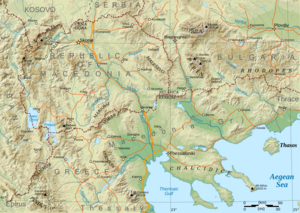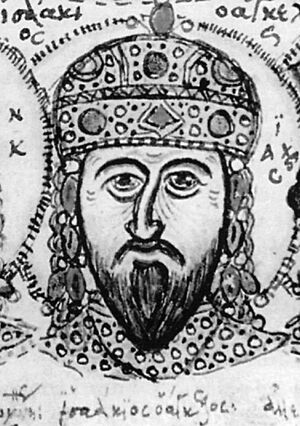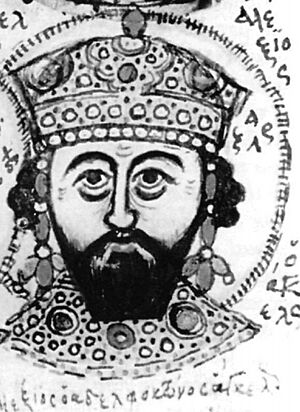Manuel Kamytzes facts for kids
Quick facts for kids
Manuel Kamytzes
|
|
|---|---|
| Born | c. 1150 |
| Died | after 1202 |
| Allegiance | Byzantine Empire |
| Years of service | 1185/86–1199 |
| Rank | protostrator |
| Battles/wars |
|
Manuel Kamytzes was a brave Byzantine general who lived in the late 1100s. He was a cousin to the emperors Isaac II Angelos and Alexios III Angelos. Manuel held a very important military rank called protostrator. This meant he was a top commander in the Byzantine army.
From 1185 to 1199, Manuel fought in many battles across the Balkans. He helped defend the Byzantine Empire from invaders and rebels. Later, he led his own rebellion against his cousin, Emperor Alexios III, but it was not successful.
Contents
Who Was Manuel Kamytzes?
Manuel Kamytzes was born around 1150. His mother was Maria Angelina Komnene. This meant he was related to three powerful Byzantine royal families: the Angelos, Doukas, and Komnenos families. His father, Constantine Kamytzes, was also a respected general.
Manuel was a first cousin to emperors Isaac II and Alexios III. Being part of such an important family meant he had a high position in the empire.
Manuel's Military Career
Manuel Kamytzes first appears in history in 1185. He was a commander during a battle against invaders from Italy who were attacking the city of Thessalonica.
Serving Emperor Isaac II
In 1185, Manuel's cousin, Isaac II, became emperor. Manuel was given the high rank of protostrator. This title was usually given to very important nobles who were close to the emperor.
Manuel played a key role in stopping a rebellion led by General Alexios Branas in 1186 or 1187. Manuel even used his own money to help the emperor fight the rebels. He commanded part of the army that defeated Branas outside the walls of Constantinople.
In 1187, Manuel fought against a rebellion by the Vlachs and Bulgarians in the northern Balkans. He helped defeat a large group of Cuman raiders and freed many prisoners.
In 1189, Manuel faced the army of Frederick I Barbarossa during the Third Crusade. Barbarossa's German forces were crossing Byzantine lands. Manuel was ordered to watch them and attack their supply groups. However, the Germans learned of his plans and attacked Manuel's camp. Manuel's forces were defeated, and he had to flee.
In 1190, Manuel again fought against the Bulgarian rebels in the Balkan Mountains. He commanded the front part of the army. During a retreat through a narrow pass, the Bulgarians attacked the main army, causing panic and a defeat.
Serving Emperor Alexios III
After Isaac II was overthrown by his brother Alexios III, Manuel kept his high position. He even held the reins of the new emperor's horse during the coronation ceremony.
In 1196, Manuel was sent to help the Bulgarian leader Ivanko, who had taken control of the Bulgarian capital, Tarnovo. However, Manuel's soldiers refused to fight, saying they had been on too many dangerous and pointless missions. Manuel had to turn back, and Ivanko lost Tarnovo.
In 1197, Alexios III campaigned against another Bulgarian leader, Dobromir Chrysos. The emperor made a deal with Chrysos, who agreed to accept Byzantine rule. As part of the deal, Chrysos married Manuel's daughter. She was forced to divorce her first husband to marry Chrysos.
In 1199, Manuel was sent to fight Ivanko again, who had rebelled against the Byzantines. Manuel's forces captured several fortresses. However, Ivanko set a trap. He pretended to be moving livestock and prisoners. When Manuel's soldiers went to take the goods, Ivanko attacked them and captured Manuel. This was a big setback for the Byzantines.
Imprisonment and Rebellion
While Manuel was in prison, Emperor Alexios III did something surprising. He took all of Manuel's wealth and even put Manuel's wife and son in prison. Manuel sent letters begging the emperor to pay his ransom, but Alexios refused.
After about a year, Manuel turned to his son-in-law, Dobromir Chrysos. Chrysos agreed to pay the ransom, which was a huge amount of gold. Manuel was freed and went to Chrysos's fortress. From there, he again asked the emperor to repay Chrysos from his own confiscated money. But Alexios refused once more, valuing Manuel's wealth more than their family ties.

Manuel was furious with the emperor. He joined Chrysos in a rebellion against the Byzantine Empire. They easily captured cities like Pelagonia and Prilep, and then took control of Thessaly. While Chrysos returned to his own lands, Manuel stayed in Thessaly. This rebellion also inspired other uprisings in the empire.
The emperor sent his armies to fight Manuel. In autumn 1201, Alexios III himself led the army. But in the end, diplomacy worked better. The emperor offered Chrysos his granddaughter in marriage. Chrysos accepted, gave up some of his lands, and likely divorced Manuel's daughter.
At the same time, the emperor offered Manuel a pardon and his old rank back. But Manuel refused. The Imperial army then invaded Thessaly. Manuel's army was defeated, and he was wounded in the leg. He fled the battlefield and abandoned Thessaly.
After this defeat, we don't know much more about Manuel Kamytzes. He likely found safety in Bulgaria and died soon after.
Manuel's Family
Manuel married around 1170, but his wife's name is not known. He had a daughter who was forced to marry Dobromir Chrysos. He also had a son named John Kamytzes.
After Manuel's death and the fall of Constantinople in 1204, his family moved to Nicaea. The Kamytzes family was one of the wealthiest and most important noble families in the Byzantine Empire.
Sources
- Choniates, Nicetas (1984). O City of Byzantium, Annals of Niketas Choniatēs. Detroit: Wayne State University Press. ISBN 0-8143-1764-2. https://books.google.com/books?id=O8arrZPM8moC.
- Guilland, Rodolphe (1967). [Manuel Kamytzes at Google Books "Le Protostrator"] (in French). Recherches sur les institutions byzantines. Berliner byzantinische Arbeiten 35. I. Berlin and Amsterdam: Akademie-Verlag & Adolf M. Hakkert. pp. 478–497. OCLC 878894516. Manuel Kamytzes at Google Books.
- "The Oxford Dictionary of Byzantium".. (1991). Oxford and New York: Oxford University Press.
- Varzos, Konstantinos (1984) (in el). Η Γενεαλογία των Κομνηνών. A. Thessaloniki: Centre for Byzantine Studies, University of Thessaloniki. OCLC 834784634. http://www.kbe.auth.gr/sites/default/files/bkm20a2.pdf.
- Varzos, Konstantinos (1984) (in el). Η Γενεαλογία των Κομνηνών. B. Thessaloniki: Centre for Byzantine Studies, University of Thessaloniki. OCLC 834784665. http://www.kbe.auth.gr/sites/default/files/bkm20b.pdf.



